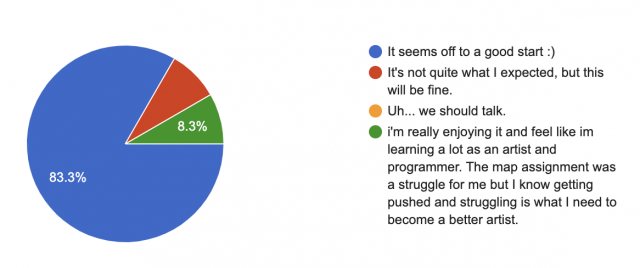Agenda
- Responses to 9/2 Exit Ticket (below)
- Reminder about recently-posted videos (shaping functions, etc.)
- Some different environments/IDEs for programming in p5.js
- Web Editor (online)
- OpenProcessing (online)
- Sublime Text editor with local server (offline), e.g. in the terminal, run
-
cd myDirectoryContainingP5 python -m SimpleHTTPServer
- visit http://localhost:8000/
-
- Processing editor with additional p5.js mode (offline)
- Visual Studio Code with p5.js plugin (offline)
- Demonstration of exporting frames for animated loop
- All other business, and individual meetings per schedule
Some quick sample code:
function setup() {
createCanvas(500, 500);
}
function draw() {
background("pink");
strokeWeight(5);
line(width/2, height/2, mouseX, mouseY);
}
Responses to Exit Ticket of 9/2
- Are there any cool projects at the intersection of design and creative coding? Yes, many many many. The field broadly called “computational design” and includes modes of practice including interactive information visualization, cartography, computational typography, generative product design, and UX/UI design. To see some projects, look at creativeapplications.net, and look at work by designers such as the following:
Emily Gobeille, designer of high-end interactive installations for children
Mimi Son, creator of interactive artworks with novel displays
Vera-Maria Glahn, designer of high-end computational new media films and installations
Amanda Ghassei, innovative creator of tangible/computational media
Anouk Wipprecht, computational/speculative coutour designer
Jenny Sabin, architect using computational techniques to create experimental form
Jessica Rosenkrantz, leading creator of generative product designs inspired by nature
Lea Albaugh, augmented fashion designer and game developer at CMU
Leah Buechley, researcher of high/low tech hybrids, innovator in maker culture
Libs Elliott, computational quilt designer
Madeline Gannon, designer of interactive tools for digital fabrication, CMU alum
Mary Huang & Jenna Fizel, generative, digitally fabricated coutoure
Mouna Andraos & Melissa Mongiat, playful interactive public sculpture
Neri Oxman, leading research into generative digital fabrication
Fernanda B. Viégas, Co-Director of “Big Picture” data visualization group, Google
Georgia Lupi, designer and founder, Accurat
Harlo Holmes, digital rights activist/artist
Lisa Strausfeld, Head of data visualization, Bloomberg
Rachel Binx, NASA JPL visualization; Ex-Stamen; Co-Founder, Meshu
- What are some internship/full-time job opportunities that suit people like us? You can find work in fields like game design, data visualization, data journalism, web design, advertising, museum exhibition design, virtual reality, multimedia research, etc. My students have had
- What pitfalls are there when dealing with ease of sharing over the internet? How have artists engaged with ideas of virality and palatability? Probably the biggest pitfall is new media artists being ripped off by advertising agencies without credit or remuneration. There are lots of instances of this, I wrote about some of them in 2012.
- Can we manipulate photographs in p5.js? Can we used computationally manipulated photographs for the next deliverable? It is possible, and no, I would prefer that you master basic forms first.
- Is purple your favorite color? No, orange is my favorite color. Purple was my daughter’s favorite color when she asked us to paint this room. Then she changed her mind, and decided to claim a different room. The purple room was our guest-room until I took it over during COVID.
- Are we expected/ would you recommend us to find/learn different tools and algorithms that we can apply in our projects? For example, I didn’t know much about the Marching squares algorithm, but many of the others seem to already be in the well-understood state..? The others found out about Marching Squares by looking at the first page of most recent videos from Dan Shiffman’s Coding Train, which is an essential resource in our field. Shiffman has made hundreds of tutorials; if you would like to truly impress me, select a tutorial from the second page of results. And yes, you are expected to research algorithms appropriate to your concepts. If you don’t know what those might be (that’s reasonable!), come to office hours and ask for some advice about how to realize your ideas.
- Do you think a finished and well-developed digital project is better than one that is less complete but more risk-taking and creative? This class is structured in such a way that you will probably never have the time to make a “finished and well-developed” project. Sorry. Instead, you will be developing fluency by making a diverse range of experiments that stretch your skills, and which you can polish at a later time. I guess you can infer that I would prefer that you take risks and be creative.
- How should artists document or preserve obsolete new media art? This is a great question. Documentation and preservation are very different issues. There are consultancies in the business of helping museums rescue interactive media art that was made for obsolete hardware, such as Ben Fino-Radin’s Small Data Industries; see also this article that Ben wrote. Renowned new media artist Rafael Lozano Hemmer has written a fantastic resource on how his studio preserves and documents their work; I consider this document to be a gold standard. If you would like to know more, here is a repository of videos from a conference on the topic.
